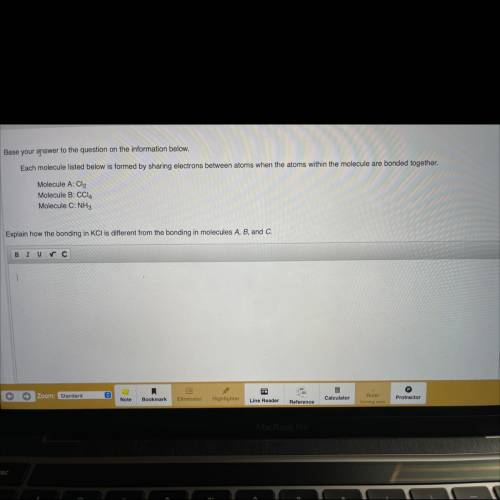
Chemistry, 26.02.2021 01:00 Catgirl7060
Castle Learning- Each molecule listed below is formed by sharing electrons between atoms when the atoms within the molecule are bonded together.
Molecule A: Cl2
Molecule B: CC14
Molecule C: NH3
Explain how the bonding in KCl is different from the bonding in molecules A, B, and C.
(Picture)


Answers: 3
Another question on Chemistry

Chemistry, 22.06.2019 08:30
In the millikan oil drop experiment they determined that every drop had a charge which was a while number multiple of -1.60x10^-19. if a drop has a total charge of -9.60x10^-19 then how many excess electrons are contained within the drop?
Answers: 2

Chemistry, 22.06.2019 11:20
Which of the following contributes to the structural rigidity of cellulose? adjacent glucose polymers are stabilized by hydrogen bonding. glucose residues are joined by (α1→4) linkages. cellulose is a highly branched molecule. the conformation of the glucose polymer is a coiled structure.
Answers: 2

Chemistry, 22.06.2019 14:50
Given the following information: mass of proton = 1.00728 amu mass of neutron = 1.00866 amu mass of electron = 5.486 × 10^-4 amu speed of light = 2.9979 × 10^8 m/s calculate the nuclear binding energy (absolute value) of 3li^6. which has an atomic mass of 6.015126 amu. j/mol.
Answers: 2

Chemistry, 23.06.2019 05:00
1. true or false: minerals are inorganic. true false 2. inorganic means that something has never been found alive 3. halite is another name for and is a mineral with a cubic crystal pattern. table salt rock salt
Answers: 1
You know the right answer?
Castle Learning- Each molecule listed below is formed by sharing electrons between atoms when the at...
Questions

Biology, 20.09.2019 10:30

Mathematics, 20.09.2019 10:30


Biology, 20.09.2019 10:30


Mathematics, 20.09.2019 10:30


History, 20.09.2019 10:30

Mathematics, 20.09.2019 10:30

Geography, 20.09.2019 10:30



Social Studies, 20.09.2019 10:30

Mathematics, 20.09.2019 10:30

Mathematics, 20.09.2019 10:30

Mathematics, 20.09.2019 10:30






